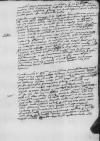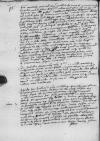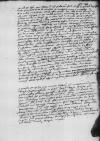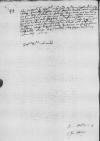Hac hora mihi significavit ⌊Velzerorum⌋ factor hac nocte se tacite postam per ⌊Franciam⌋ in ⌊Italiam⌋ missurum unde, si quid velim scribere, se id libenter in suum fasciculum ligaturum; quam occasionem et scribendi opportunitatem nequaquam omittendam duxi, praesertim cum manus mea rectius valet. Proinde quicquid pro hac temporis angustia sum scripturus, quae obiter calamo incidunt, Maiestas Vestra Serenissima boni consulere dignabitur.
⌊⌋ per eundem ⌊Velzerorum⌋ factorem 1527-04-22⌊22 mensis novissime praeteriti1527-04-22⌋ ex tempore, quae tum se offerebant. Interea nihil operae et diligentiae praetermisi, quo mandatis Maiestatis Vestrae Serenissimae super adoha satisfieret. Conveni paulo ante bis ⌊caesarem⌋ et illi haec gravamina, quibus ⌊vicerex⌋ Maiestatem Vestram Serenissimam in ⌊Statu Barensi⌋ molestare audet, non sine vehementia et ex animo exposui illique supplicationem desuper, cuius exemplum mitto praesentibus, reddidi, ad quod mihi respondit: „Si quid fortassis in ⌊Regno Neapolitano⌋ desuper foret institutum, id factum esse necessitate exigente”. Ad quod ego subintuli: „Istiusmodi necessitatem non debere praeiudicare iuribus et exemptionibus Maiestatis Vestrae Reginalis, et multo minus illustrissimae olim dominae ⌊matri⌋ Maiestatis Vestrae, a qua tale servitium per ⌊regem praeclarae memoriae catholicum⌋ numquam fuit exactum, sed fuisset ut filia regis in ea praerogativa semper conservata; neque credere Maiestatem Vestram Reginalem id umquam de mente maiestatis suae processisse, tametsi ⌊vicerex⌋ se iactaverit, specificam super id habuisse commissionem”. Addidi et alia ad longum, quae videbantur expedire.
Respondit ⌊maiestas sua⌋ se de his rebus nescire, nihilominus tamen ea se facturum, quae mutuae coniunctioni atque aequitati convenirent remisitque supplicationem meam ad ⌊Iohannem Laleman(tum)⌋, secretarium primarium, qui iam absente ⌊cancellario⌋ omnia dirigit et nihil expedit. ⌊Illum⌋ iam aliquoties conveni et vix apud eum tantum effeci, ut supplicationem meam ⌊caesari⌋ datam 24 Aprilis novissimi, quae tam diu apud illum S(?) delituit, domino ⌊Sigismundo Loffredo⌋ ante tres dies mitteret. Fuique apud dominum ⌊Sigismundum⌋ paulo ante et cum eo super hac adoha ad longum contuli. ⌊Qui⌋ dicit se omnia facturum, quae sunt possibilia, sed adhuc relationem de supplicatione mea nondum fecit neque scit, ut ex eo intellexi, cui facere debeat, cum prius istiusmodi relationem ⌊cancellario⌋ facere solebat, qui deinde subscripsit decretationes et misit ⌊secretario⌋. Iam omnis ordo corruptus est. Nemo est, qui negotiis intendat. ⌊Caesar⌋ etiam ad haec nulli adhuc dedit facultatem. Exspectatur reditus domini ⌊cancellarii⌋, qui nisi dignis se condicionibus habitis non redibit umquam, sic enim ex eo intellexi, antequam hinc abiret. Idque adhuc ⌊Corneliu⌋s confirmat, cuius paulo ante ⌊⌋ ex ⌊Fraga⌋ et ex ⌊Monte Serrato⌋ accepi, nihilque aliud quam commodum ad navigationem tempus exspectat.
Incidimus iterum in hanc opportunitatem cum hoc  BCz, 242, p. 90 negotio, quod nescio quando expediri poterit. Ego hic vi nihil evincere possum. Imponunt mihi officiales omnes, et, ut rectius loquar, sine pudore mentiuntur. Traducor de uno ad alium et omnes has moras nectunt. Si venio ad ⌊caesarem⌋, remittit me ad ⌊Lalmant⌋, ille ad ⌊Sigismundum⌋, hic rursus ad caesarem. Iam mores eorum apprime nosco. Sic faciunt, cum nihil facere volunt, vel cum aliud exspectant, quod iam transactum esse velint, vel forsan prius volunt scire a ⌊vicerege⌋, quid ea in re facere debeant. Interea ego in hac rota ad hunc modum circumvolvar, donec id habeant, quod exspectant. Aliud hic omni meo studio et vigilantia extorquere non potero, etiamsi rumpar. Dominus tamen ⌊Sigismundus⌋ me confortat verbis, ut hic fit, aulicis, quae si non intelligerem, facile mihi imponeretur; sed qui in hoc ludo tamdiu hic versor, deceptus prius aliquoties, difficulter indicor[1].
BCz, 242, p. 90 negotio, quod nescio quando expediri poterit. Ego hic vi nihil evincere possum. Imponunt mihi officiales omnes, et, ut rectius loquar, sine pudore mentiuntur. Traducor de uno ad alium et omnes has moras nectunt. Si venio ad ⌊caesarem⌋, remittit me ad ⌊Lalmant⌋, ille ad ⌊Sigismundum⌋, hic rursus ad caesarem. Iam mores eorum apprime nosco. Sic faciunt, cum nihil facere volunt, vel cum aliud exspectant, quod iam transactum esse velint, vel forsan prius volunt scire a ⌊vicerege⌋, quid ea in re facere debeant. Interea ego in hac rota ad hunc modum circumvolvar, donec id habeant, quod exspectant. Aliud hic omni meo studio et vigilantia extorquere non potero, etiamsi rumpar. Dominus tamen ⌊Sigismundus⌋ me confortat verbis, ut hic fit, aulicis, quae si non intelligerem, facile mihi imponeretur; sed qui in hoc ludo tamdiu hic versor, deceptus prius aliquoties, difficulter indicor[1].
Dixit etiam mihi, hodie Maiestati Vestrae Reginali et magnifico domino ⌊Ludovico Aliphio⌋ se scripturum, in cuius negotio plurima sumus locuti; ⌊ipse⌋ bene sperare iubet, indultum hoc nos aliquando habituros, prout ex illius litteris videbitur. Ego certe credo, quod libenter, quantum ⌊illi⌋ licet, rebus Maiestatis Vestrae Serenissimae inserviret, sed non omnia sunt in manu sua cogiturque caute incedere, ne ⌊viceregem⌋ offendat, a quo, ut mihi videtur, totus dependet, et sine dubio vicerex in fratrem illius uterinum ⌊Cola Mariam de Summa⌋ consentiet, ut ⌊arci Barensi⌋ praeficiatur, si eum Maiestas Vestra nominaverit. Sicque habitura est castellanum etc.
Non possum satis mirari. Accepi superioribus diebus ⌊⌋ domini ⌊Scipionis de Summa⌋, quas praesentibus adiunxi. In quibus mihi scribit, quod ⌊⌋ meas ex ⌊Granata⌋ habuerit, cum quibus illi provisionem caesaream de adoha transmisi, et ne uno quidem verbo istius provisionis meminit. De aliis quidem scribit, quas ⌊illi⌋ Maiestas Vestra Reginalis transmisit, de ista adoha plane conticuit. Scripsit item domino ⌊Sigismundo⌋, fratri suo, etiam de aliis, et me ac negotia Maiestatis Vestrae, quantum ⌊illi⌋ liceret, commendavit, sed de adoha nullam fecit mentionem, de quo etiam dominus Sigismundus miratur, dixitque hodie, quod si Maiestas Vestra ea in re a ⌊vicerege⌋ haberet difficultatem aliquam, Scipionem utique illam vel sibi, vel mihi descripsisse, unde posse nequaquam fieri, quod in ista adoha Maiestas Vestra Serenissima molestaretur. Ego tamen in omnem eventum rogavi, ut daret operam, quod quantocius supplicatio mea expediretur. Ad quae, ut prius scripsi, dixit, se facturum omnia, quae sint possibilia.
Sic hucusque in hoc negotio haeremus. Ceterum a me nihil omittetur, quoad eius fieri poterit, quod ex re et ex usu esse videbitur. Adiunxi etiam praesentibus  BCz, 242, p. 91 exemplum istius provisionis de adoha, quam ex ⌊Granata⌋ per manus domini ⌊Sigismundi Loffredi⌋ duplicatam domino ⌊Scipioni de Summa⌋ ⌊⌋. Aliam, quae se ad consuetudinem referret, nullo pacto hic impetrare potui.
BCz, 242, p. 91 exemplum istius provisionis de adoha, quam ex ⌊Granata⌋ per manus domini ⌊Sigismundi Loffredi⌋ duplicatam domino ⌊Scipioni de Summa⌋ ⌊⌋. Aliam, quae se ad consuetudinem referret, nullo pacto hic impetrare potui.
Ostendit mihi ⌊Sigismundus Loffredus⌋ litteras creditivas, quas illi Maiestas Vestra Serenissima in meam personam miserat, vigore quarum ego illi uberem gratiam Maiestatis Vestrae sum pollicitus, ut efficeret, quantum sibi conveniret, ut tandem istius tragoediae semel finem habere possemus, cum iam sint tres anni elapsi et adhuc huius labyrinthi exitum non habemus et semper perplexe on the margin in place of crossed-out praetexe(?)⌈praetexe(?) perplexe perplexe on the margin in place of crossed-out praetexe(?)⌉ in his actionibus tractatum est hactenus, quo demum plane ⌊Status Barensis⌋ ad manus Maiestatis Vestrae Serenissimae pervenire posset. Refricuique ⌊illi written over ...⌈... illegible⌈...... illegible⌉illiilli written over ...⌉⌋ omnes ⌊viceregis⌋ technas, quibus eum ⌊statum⌋ occupare contendebat, et novissimas in ⌊Ducatu Mosoviae⌋, ut Maiestas Vestra ex ⌊⌋ ad serenissimam ⌊maiestatem regiam⌋ latius intelliget. Ad ea mihi respondit verum quidem esse, fuisse quosdam malos conatus, qui tamen non successissent written over um⌈umissentissent written over um⌉ et id, quod adhuc practicaretur, non posse Maiestati Vestrae Serenissimae obesse, quippe cum si<n>t remotae consideratione written over i⌈iee written over i⌉s, et iste secretarius ⌊Lalmant⌋ nondum h rerum haberet scientiam, consuluitque mihi, ut illum arte adhuc tractarem, quousque certum ⌊cancellarium⌋ habems habemus, pollicitus e demum demum, ut prius commedat, omnem suam operam.
Scribit Maiestas Vestra Serenissima in ⌊⌋, sexta Februarii ⌊Cracoviae⌋ datis, ut in ... illegible⌈...... illegible⌉ e<x>peditione adscribed⌈nene adscribed⌉ lre(?) litterarum de exemptione adohae largitionibus usque ad mille ducatos, ubi videretur necessarium, uti deberem. Credat mihi Maiestas Vestra Serenissima, quod absente ⌊cancellario⌋, qui hic solus fuit incorruptus, plerique invenirent<ur>, qui acciperent et nihil expedirent, quandoquidem omnia, quae ⌊Regnum Neapolitanum⌋ spectant, a ⌊vicerege⌋ dependent dependere, et sic ms. hoc(!)
⌈sicsic ms. hoc(!)
⌉
contra illum nemo hiscere on the margin in place of crossed-out hiscere⌈ his written over sin⌈sin his his written over sin⌉cere hiscere hiscere on the margin in place of crossed-out hiscere⌉ audet written over audita⌈audita audet audet written over audita⌉. Mirum est, quod ne superinscribed⌈nene superinscribed⌉ ⌊caesar{em}⌋ quidem contra ⌊illius⌋ edicta quicquam statuere praesumit. ⌊Quem⌋ dominus ⌊cancellarius⌋ incantatum esse ab ⌊eo⌋ omnino affirmat.
Et cum ita rem geri video, adhuc me continebo, nollem enim piscari in aere, nihil tamen intemptatum relinquam, quod ad eam rem facto opus erit. Conveniam cras, si fieri potest, vel post crastinum ⌊caesarem⌋, qui hic iterum venatum iturus est et forte non redibit umquam, quousque imperatrix pepere superinscribed⌈rere superinscribed⌉rit, quod multi circa finem istius mensis futurum arbitrantur. Instabo, urgebo et de hac superinscribed⌈de hacde hac superinscribed⌉ tam tarda written over ...⌈... illegible⌈...... illegible⌉tardatarda written over ...⌉ expeditione quelis querelis ⌊maiestatem  BCz, 242, p. 92 suam⌋ onerabo, quoad sciam, quid sibi cum iis moris velint. ⌊⌋ Maiestas Vestra Serenissima celeritate opus esse et ego id infitias ire non possum scribit Maiestas Vestra Serenissima, porro non possum plus, quam vires meae valeant. Utinam ea superinscribed⌈eaea superinscribed⌉ mea valli esset facultas, quam saepius opto, postquam cum istis hic sycophantis digladiari soleo, dudum ego hinc essem liberatus et Maiestas Vestra Serenissima primo mense, quo ⌊huc⌋ veni, rerum suarum habuisset finem.
BCz, 242, p. 92 suam⌋ onerabo, quoad sciam, quid sibi cum iis moris velint. ⌊⌋ Maiestas Vestra Serenissima celeritate opus esse et ego id infitias ire non possum scribit Maiestas Vestra Serenissima, porro non possum plus, quam vires meae valeant. Utinam ea superinscribed⌈eaea superinscribed⌉ mea valli esset facultas, quam saepius opto, postquam cum istis hic sycophantis digladiari soleo, dudum ego hinc essem liberatus et Maiestas Vestra Serenissima primo mense, quo ⌊huc⌋ veni, rerum suarum habuisset finem.
Subiungit etiam pro Maiestas Vestra Reginalis, quod hic litteras obtinere debeam, quibus ⌊viceregi⌋, et in b written over su⌈subb written over su⌉bsentia ⌊collaterali consilio⌋, mandetur, quod nihil contra ⌊Statum Maiestatis Vestrae Serenissimae Barensem ms. is(!)
⌈emem ms. is(!)
⌉⌋ innova superinscribed in place of crossed-out ue⌈uevava superinscribed in place of crossed-out ue⌉re debeant etc. Id etiam proposui. Responsum est, quod debeam litteras observatorias in ampla forma habere, nam hic a stilo dem(?) cancellariae non discedi written over e⌈eii written over e⌉tur. Eas cum ⌊Fabiano⌋ et postea duplicatas Maiestati Vestrae Serenissimae transmisi, in iis omnia, quae perscripsit, et maiora inveniet; modo velint observare, quod in illis continetur. Videntur mihi aliae non esse superinscribed in place of crossed-out necess⌈necessnon essenon esse superinscribed in place of crossed-out necess⌉ necessariae neque etiam alias hic ultra stilum huius curiae impetrare potero. Adeo inhaerent hic secretarii suis ineptiis, ut facilius ⌊Herculi⌋ clavam eriperem, quam illos ab eorum institutis, in quibus se pertinaciter figunt, amoverem.
De sobellis ⌊⌋ Maiestati Vestrae Serenissimae 22 mensis praeteriti. Exspectabo donec enixa foret ⌊imperatrix⌋ et cum aliqua digna occasione in rem Maiestatis Vestrae Reginalis illos offeram. Viderunt hic apud me istas pelles quidam mercatores, qui eos hic dicunt valere mille ducatos. Quas itaque adhuc apud me observabo et sic me cum illis geram, ne videar aerem verberasse.
Hodie hic habita est omnium ecclesiarum processio pro futuro ⌊imperatricis⌋ partu, de qua, cum tantum nocti adhuc otii mihi superest, pauca adnotare non supervacaneum censui. Intravit hic domina ⌊imperatrix⌋ 1527-02-22⌊22 Februarii praeteriti1527-02-22⌋, ex ⌊Granata⌋ usque huc written over ...⌈... illegible⌈...... illegible⌉ huc huc written over ...⌉ in lectica perlata semper es in humeris 24 hominum. Fuit hic variis ludis on the margin in place of crossed-out ludus⌈ludus ludis ludis on the margin in place of crossed-out ludus⌉ et spectaculis magna hominum frequentia suscepta. Contulerat se ad ⌊illam⌋ usque ⌊Seg<o>viam⌋ 17 abhinc leugis ⌊caesar⌋ et cum illa usque prope ⌊huius civitatis⌋ portam pervenit. Hinc incognitus, relicta ⌊ea⌋ cum magnatibus, ⌊civitatem⌋ intravit et ad suum palatium se contulit. ⌊Illa⌋ ferebatur in lectica non secus atque mortui ab ms. ad(!)
⌈abab ms. ad(!)
⌉ hominibus ad sepulcra ferri solent. Numquam vidi simile spectaculum, cadavera etiam in feretris eo modo sic exornatis, ut erat lectica, portari solent solent;  BCz, 242, p. 93 et ab eo tempore, quo illata est ad palatium suum, numquam amplius est egressa; vix permittitur, ut se moveat et magna cura a medicis et aniculis custoditur.
BCz, 242, p. 93 et ab eo tempore, quo illata est ad palatium suum, numquam amplius est egressa; vix permittitur, ut se moveat et magna cura a medicis et aniculis custoditur.
Deus Optimus Maximus det ⌊illi⌋ lenem partum. In 28 anno concepit et est valde macra timeturque de pariendo. Opinantur multi, ut scripsi, quod in fine vel <vel> circa istius mensis sit paritura. Fertur, quod cum pepererit et infans tantum adoleverit, fueritque tantarum virium, quod portari possit, nos hinc discessuros ad omnia regna ⌊Hispaniae⌋, ut infanti homagium praestetur et iuretur. Et cum in haec inciderim, quae sunt de foro Maiestatis Vestrae Serenissimae, sciat etiam superinscribed in place of crossed-out eius(?)⌈eius(?) etiam etiam superinscribed in place of crossed-out eius(?)⌉ Maiestas Vestra, quod coniunx{i} domini ⌊comitis de Nassaw⌋ quinta Martii filium peperit, qui vix ad spatium unius horae vixit et iis est ille ms. illi(!)
⌈illeille ms. illi(!)
⌉ iam secundus partus, et infaustus. Domina ⌊imperatrix⌋ habet secum omnes adhuc, quos huc adduxerat, ⌊Portugalenses⌋, sed cum nuper ⌊caesar⌋ intellexit dominum ⌊reg{s}em Portugaliae⌋ omnes ⌊Castellanos⌋ dimisisse, qui cum sorore sua ⌊Catherina⌋ illuc advenerant, decrevit etiam post partum statum dominae imperatricis immutare.
Domina ⌊Leonora⌋, soror ⌊caesaris⌋, quam adhuc vocant reginam ⌊Franciae⌋, hic agit, aliud nihil haberet. Illustrissimus dominus ⌊dux Calabriae⌋ vivit ⌊Valentiae⌋ cum mole illa carnea domina regina ⌊Germana⌋ et plus, quam uxori, fertur dare venationi operam. Ferunt ⌊eum⌋ dixisse, quod ea de re ⌊illam⌋ duxisset, ut cum illa viveret, non ut apud illam, quemadmodum ⌊alii⌋, moreretur. Sibi consuluit, ut ⌊eam⌋ duceret, quandoquidem ab ea habet quolibet anno octo milia ducatorum, et ex officio, quod vicerex est Valentianus, ducatorum sex milia, et fertur ⌊illi⌋ nuper addidisse quinque milia pro principe extorri. Bene ⌊illi⌋ est provisum. Unam de suis sororibus ponet cum ⌊imperatrice⌋, aliam apud se usque ad nuptias servabit. Sic transit orbis.
Sparsus est etiam hic nuper rumor confectum esse matrimonium inter ⌊regem christianissimum⌋ et ⌊filiam⌋ serenissimi ⌊regis Angliae⌋, quae prius ⌊caesari⌋ fuerat promissa. Quod si sic esset, non foret in rem ⌊caesaris⌋. Iam puto etiam scit Maiestas Vestra Serenissima matrimonium hoc conclusum inter ⌊caesaris⌋ filiam naturalem et ⌊filium⌋ primogenitum illustrissimi domini ⌊ducis Ferrariae⌋. Secretarius iste hic ⌊Ioannes Lalmant⌋ me etiam nuper interrogavit, quantum serenissima ⌊reginula⌋ primogenita serenissimae ⌊maiestatis regiae⌋ pro dote haberet, ad quod respondi tantum illam habituram, quod filiae tanti regis convenit. Nescio quae hic in nubibus castra construuntur. Sed haec de iis hactenus, quae videbantur mihi non indigna, ut in notitiam Maiestatis Vestrae Serenissimae perducerentur. De aliis, quae hic aguntur, ex meis ad serenissimam ⌊maiestatem regiam⌋ accipiet.
 BCz, 242, p. 94
BCz, 242, p. 94
Quod reliquum est, Serenissimae Maiestati Vestrae Reginali me suppliciter commendo illique humillime supplico, cum iam ⌊arcis suae Barensis⌋ certum castellanum, in quo sibi complacuit, habeat, dignetur me tandem in hoc quarto anno ex hoc tam longinquo exilio revocare. Non tamen, ut ego volo, — quandoquidem avidissime redire cupio, — sed si ulterius hac vita et servitio meo, ubi dignabitur, disponet mecum secundu ms. a(!)
⌈uu ms. a(!)
⌉m suam voluntatem, modo absentis sui servi aliquando dignam rationem habeat, ne sim perpetuo exspectans.
 BCz, 242, p. 90 negotio, quod nescio quando expediri poterit. Ego hic vi nihil evincere possum. Imponunt mihi officiales omnes, et, ut rectius loquar, sine pudore mentiuntur. Traducor de uno ad alium et omnes has moras nectunt. Si venio ad
BCz, 242, p. 90 negotio, quod nescio quando expediri poterit. Ego hic vi nihil evincere possum. Imponunt mihi officiales omnes, et, ut rectius loquar, sine pudore mentiuntur. Traducor de uno ad alium et omnes has moras nectunt. Si venio ad  BCz, 242, p. 91 exemplum istius provisionis de adoha, quam ex
BCz, 242, p. 91 exemplum istius provisionis de adoha, quam ex  BCz, 242, p. 92 suam
BCz, 242, p. 92 suam BCz, 242, p. 93 et ab eo tempore, quo illata est ad palatium suum, numquam amplius est egressa; vix permittitur, ut se moveat et magna cura a medicis et aniculis custoditur.
BCz, 242, p. 93 et ab eo tempore, quo illata est ad palatium suum, numquam amplius est egressa; vix permittitur, ut se moveat et magna cura a medicis et aniculis custoditur.





